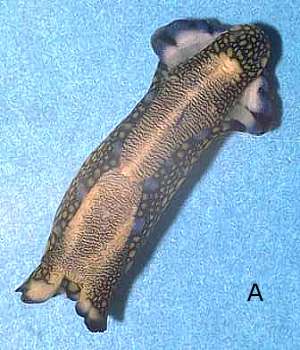
Philinopsis reticulata
(Eliot, 1903)
Order: CEPHALASPIDEA
Superfamily: PHILINOIDEA
Family: Aglajidae
DISTRIBUTION
Tropical Indo-west Pacific. (Known only from East Africa - reported in Forum from Indonesia, Australia, New Caledonia).
PHOTO
A, Fungu Yasin, Dar es Salaam, Tanzania, November 30, 1976, 32mm long alive.
B, dorsal view. Passe Deverd, 20°44.7'S, 164°15.5'E, 15-20m, outer Barrier Reef, near Koumac, New Caledonia, outside of reef, coral slabs, 13 October 1993, 1 specimen, 42mm long alive, AM C200462.
C, same as B, but ventral view with anterior end twisted around to show lateral view of head, including ridge (arrow) typical of all species of Philinopsis with long narrow muscular pharynx.
D, near Ilot Kendec, 20°40.5'S, 164°13.4'E, 18m, in Lagoon, off Koumac, New Caledonia, grey sand, 9 October 1993, 1 specimen 22mm long alive, AM C200420.
PHOTOS: Bill Rudman.
This species was described by Eliot (1903) from Wasin Is, off Kenya and has not been reported since. I found specimens in Tanzania in the 1970s, one is illustrated here, and another was identical in colour to a specimen from Sulawesi, Indonesia, illustrated in Lindsay Warren's message below. Also in that message I have added a copy of Eliot's illustration of the species. The body colour ranges from white to dull yellow and there is a reticulate pattern of brown to black all over the body, including the sole of the foot. There are blue markings on the inside edge of the anterior part of the parapodia and along the outer edge of the parapodia.
Another important character is the shape of the head, with a high median ridge, clearly seen in Photo D (arrow). This is an outward indication that this species is one of the group of Philinopsis with a very long narrow pharynx, as discussed under Philinopsis gardineri. Eliot describes this as "pharynx of moderate size, 1.5 mm wide" which means little until it is compared with his description of the foregut of a similarly sized specimen of Philinopsis cyanea - "pharynx is colossal ... breadth 15mm" - a description of the large buccal bulb, typical of most members of the genus.
Nathalie Yonow named a colour form identical to the open reticulate pattern in Photo D, from Elat, Red Sea, as a new species Aglaja phaeoreticulata. She gives no anatomical information, but the pointed shape of the head is typical of species with the long, tubular pharynx. Aglaja phaeoreticulata is a synonym of P. reticulata.
The colour pattern of Yonow's animal, white with an open black reticulation, is found from the Red Sea to New Caledonia, and the darker brown colour form with a much smaller reticulation is found from East Africa to the Western Pacific, suggesting that throughout its range P. reticulata has a variable colour pattern.
References:
• Eliot, C.N.E. (1903) Notes on some new or little known members of the family Doridiidae. Proceedings of the Malacological Society, London, 5(5): 331-337.
• Yonow, N. (1990) Red Sea Opidthobranchia 3: The orders Sacoglossa, Cephalaspidea, and Nudibranchia: Doridacea (Mollusca, Opisthobranchia). Fauna of Saudi Arabia, 11: 286-299.
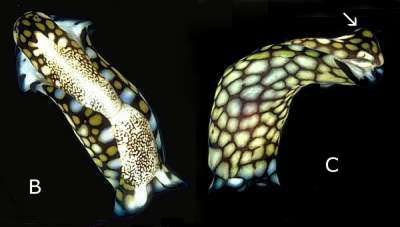
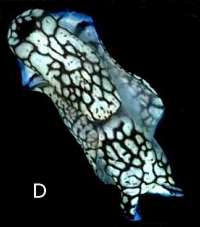
Rudman, W.B., 2000 (July 29) Philinopsis reticulata (Eliot, 1903). [In] Sea Slug Forum. Australian Museum, Sydney. Available from http://www.seaslugforum.net/find/philreti
Related messages
Re: Philinopsis reticulata laying eggs, Eilat, Red Sea
February 28, 2008
From: Binyamin Koretz
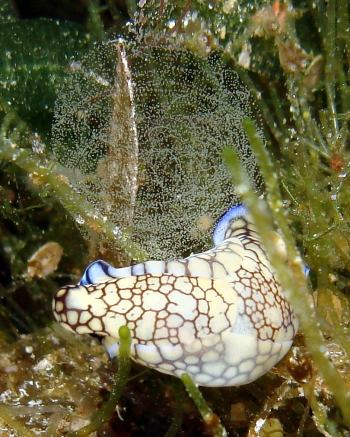
Concerning message #21396:
Dear Bill,
I found this one photo taken from a slightly lower angle, and in fact the egg mass looks to have a 3rd dimension. Something like a sphere with the top cut off?
Locality: Eilat, Satil Area, 24 m, Israel, Red Sea (Gulf of Eilat), 28 April 2007, sea grass and patch reef. Length: ca. 2.5 cm. Photographer: Binyamin and Shulamit Koretz.
best regards,
Binyamin
binyamin@koretz.net
Koretz, B., 2008 (Feb 28) Re: Philinopsis reticulata laying eggs, Eilat, Red Sea. [Message in] Sea Slug Forum. Australian Museum, Sydney. Available from http://www.seaslugforum.net/find/21402Thanks Binyamin,
It is all very interesting
Best wishes,
Bill Rudman
Philinopsis reticulata laying eggs, Eilat, Red Sea
February 27, 2008
From: Binyamin Koretz
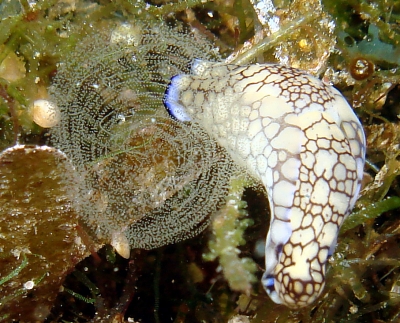
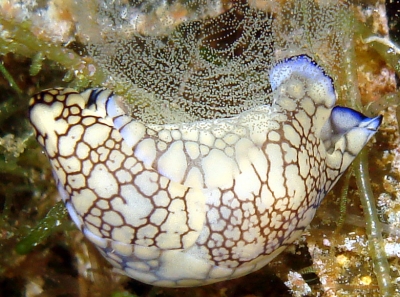
Concerning message #13297:
Dear Bill,
Here are some photos of Philinopsis reticulata (the pale variation) laying its egg coil in the sea grass.
I found it interesting that the egg coil is formed next to the animal, not around itself as we see its Chelidonura cousins do.
Locality: Eilat, Satil Area, 24 m, Israel, Red Sea (Gulf of Eilat), 28 April 2007, sea grass and patch reef. Length: ca. 2.5 cm. Photographer: Binyamin and Shulamit Koretz.
all the best
Binyamin
binyamin@koretz.net
Koretz, B., 2008 (Feb 27) Philinopsis reticulata laying eggs, Eilat, Red Sea. [Message in] Sea Slug Forum. Australian Museum, Sydney. Available from http://www.seaslugforum.net/find/21396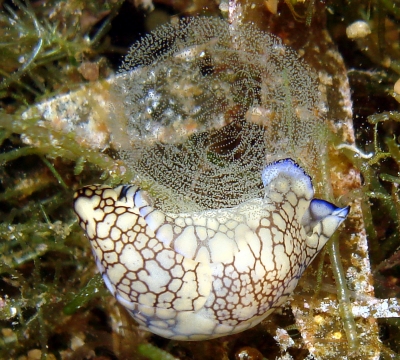
Dear Binyamin,
Thanks for this interesting observation. What I can't make out from the photo is whether the egg mass is spherical like in Chelidonura, disc shaped or cylindrical? From my experience species of Chelidonura, Melanochlamys, Navanax and most Philinopsis have a spherical egg mass which is formed by coiling it around the head as you mentioned. As I have mentioned in messages about P. gardineri and P. reticulata today there are a small group of species which we call Philinopsis which most probably should be separated into their own genus. I have discussed this on the Fact Sheet of another similar species, P. gardineri. It would be interesting if all this group of species produced this type of egg mass.
Best wishes,
Bill Rudman
Philinopsis reticulata from Reunion Island
February 27, 2008
From: Philibert Bidgrain
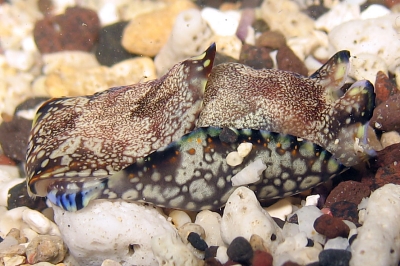
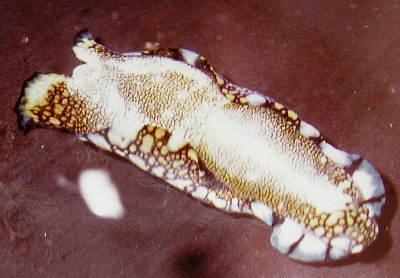
Dear Bill
We found this specimen [Upper Photo] crawling on the sustrate in a lagoon during the night [Reunion Island, Indian Ocean]. It has the same pattern that another specimen found some years ago [Lower Photos ]
Do you think that it's a variant of P. cyanea or of P. reticulata?
Best regards
Philibert Bidgrain
pbidgrain@yahoo.fr
http://vieoceane.free.fr/runseaslug/indexslug.htm
pbidhrain@yahoo.fr
Bidgrain, P., 2008 (Feb 27) Philinopsis reticulata from Reunion Island. [Message in] Sea Slug Forum. Australian Museum, Sydney. Available from http://www.seaslugforum.net/find/21218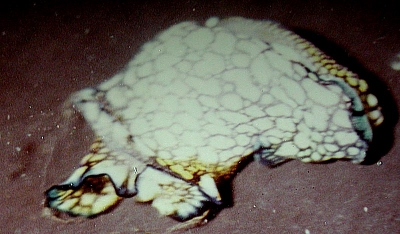
Dear Philibert,
These are two quite distinct species. The upper is P. cyanea and the lower P. reticulata. It's not easy to see from these photos but P. cyanea has a broad anterior end to the head and the posterior end of the headshield is a raised flap with a prominent median crest. P. reticulata on the other hand belongs to a 'subgroup' of the genus Philinopsis with a narrow anterior end to the head and a simple rounded posterior end to the head shield. There are major internal differences to the foregut which usually show externally as a rounded median bump at the front of the head.
Best wishes,
Bill Rudman
Philinopsis reticulata from the Red Sea
October 28, 2005
From: Jasper Lansink
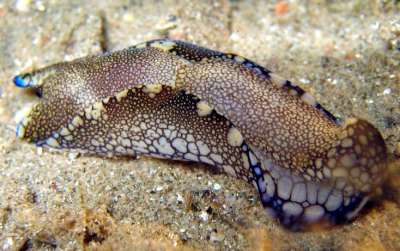
I found this slug while diving in the Northern Red Sea (Dahab). I think it must be a Chelidonura or Philinopsis of some kind, but which one?
Locality: Dahab, Egypt, Red Sea. Depth: 8 meters. Length: 5 cm. 5 October 2005. Seagrass. Photographer: Maurice de Boer
Thanks for your answer.
Jasper Lansink
jasper@aquadonna.nl
Lansink, J.A.G., 2005 (Oct 28) Philinopsis reticulata from the Red Sea. [Message in] Sea Slug Forum. Australian Museum, Sydney. Available from http://www.seaslugforum.net/find/15110Dear Jasper,
You are right in thinking it is an aglajid. It is Philinopsis reticulata. It is quite variable in colour, but the shape of the head and the blue spots around the edges are quite characteristic.
Best wishes,
Bill Rudman
Philinopsis reticulata from Eilat, Red Sea
March 8, 2005
From: Binyamin Koretz
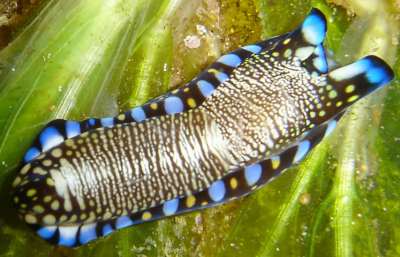
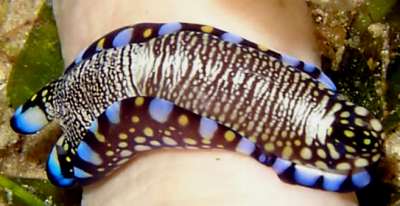
Hi Bill,
The attached photos of Philinopsis reticulata will establish the range of this East African color form in the Red Sea all the way to Eilat.
Locality: Eilat, Tables South, Israel, Red Sea. Depth: 28 m. Length: ca. 3 cm. 04 March 2005. sea grass. Photographer: Binyamin and Shulamit Koretz
Each time I tried to move aside the sea grass to get a clear photo, this friendly little guy made a beeline for my hand - as you can see in the photo where he's wrapped around my finger. And shaking him off gently wasn't so easy - he hangs on by his mouth (what else can he do?) and doesn't like to let go!
best regards
Binyamin
binyamin@koretz.net
Koretz, B., 2005 (Mar 8) Philinopsis reticulata from Eilat, Red Sea. [Message in] Sea Slug Forum. Australian Museum, Sydney. Available from http://www.seaslugforum.net/find/13297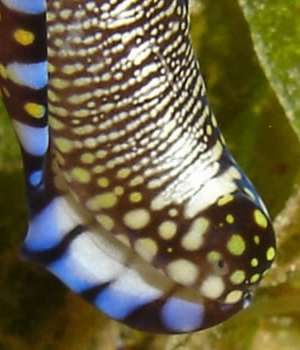
Dear Binyamin,
Thanks for the record and the beautiful photos. As I mention on the species Fact Sheet, Nathalie Yonow named another colour form of this species from Eilat, Red Sea, as a new species Aglaja phaeoreticulata. So it is good to get a 'typical' east African colour form from the same locality.
I suspect it was hanging on your finger, not so much by its mouth, but by the sticky mucus secretions it secretes from gland just under it mouth.. Aglajids lay down a sheet of mucus on which to crawl as they walk along, and those that burrow in the sand or mud produce a complete tube of mucus to crawl through, which I guess stops their gills getting clogged up. In the close-up of the head, I have included alongside my comments, the black spot is its right eye.
Best wishes,
Bill Rudman
Philinopsis reticulata from Anilao
July 13, 2003
From: Ray Izumi
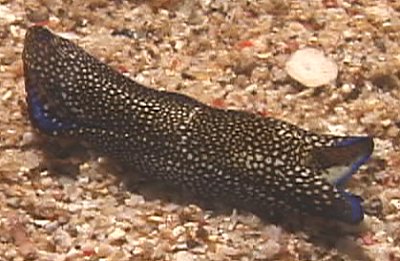
Do you recognize this critter? I photographed it at Anilao, Batangas, Philippines. It looks like a Philinopsis, but I can't find anything that looks quite like it.
Ray Izumi
izumirm@sprynet.com
Izumi, R., 2003 (Jul 13) Philinopsis reticulata from Anilao. [Message in] Sea Slug Forum. Australian Museum, Sydney. Available from http://www.seaslugforum.net/find/10150Dear Ray,
This is Philinopsis reticulata.
Best wishes,
Bill Rudman
Philinopsis reticulata from Chek Jawa, Singapore
February 3, 2003
From: Ria Tan
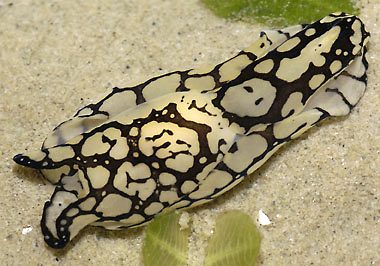
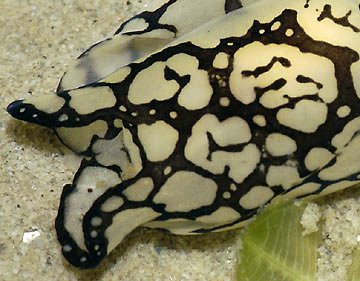
Dear Bill,
Here ia another animal from the intertidal flat at Chek Jawa, Singapore. Photo: Alan Yeo
Best wishes,
Ria Tan
tanria@singnet.com.sg
Tan, R., 2003 (Feb 3) Philinopsis reticulata from Chek Jawa, Singapore. [Message in] Sea Slug Forum. Australian Museum, Sydney. Available from http://www.seaslugforum.net/find/9053Dear Ria,
I'm pretty sure this is a colour variation of Philinopsis reticulata. It looks very like Philinopsis pilsbryi, but in that species the black lines don't extend on to the inside of the parapodia. It is a member of the Aglajidae, a family of highly mobile carnivorous sea slugs, which hunt down their prey by following its slime trail. Many species of Philinopsis eat bubble shells, such as Bulla and Haminoea, by swallowing them whole. However, P. reticulata is one of a group of species of Philinopsis which we think eats something else because it has a very different foregut. Up until know however we don't know what it eats. Perhaps polychaete worms.
Best wishes,
Bill Rudman
Philinopsis reticulata from the Red Sea
April 7, 2002
From: Jacob Dafni
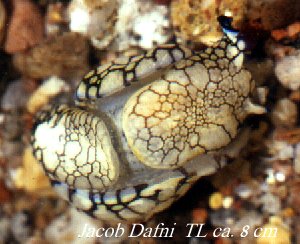
Dear Dr. Rudman,
Yet another unknown slug picture. It was taken among algae and rubble in the subtidal zone, Eilat, Northern Red Sea, in 1985. I am not sure about its size. The best I could do is to affiliate it to the Cephalaspidea.
Thank You in advance.
Dr Jacob Dafni
jdafni@netvision.net.il
Dafni, J., 2002 (Apr 7) Philinopsis reticulata from the Red Sea. [Message in] Sea Slug Forum. Australian Museum, Sydney. Available from http://www.seaslugforum.net/find/6676Dear Jacob,
This is indeed a cephalaspid. It is a pale colour form of Philinopsis reticulata.
Best wishes,
Bill Rudman
Philinopsis reticulata from South Africa
July 31, 2001
From: Valda Fraser
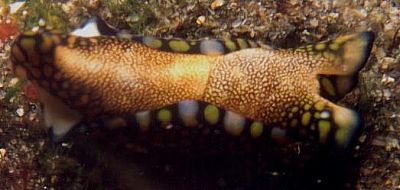
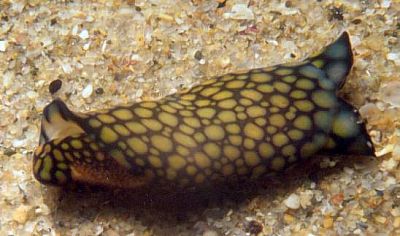
Dear Bill
This creature caused me endless frustration. I managed a reasonable photo of its underside, but as for the dorsal area! It kept trying to hide under the sand. Unfortunately a big wave came and swept it away before I could take an adequate photo. Well, ... hopefully you can see enough to identify it. Thanks.
Locality: Pumula, south coast KwaZulu-Natal, SOUTH AFRICA, intertidal zone
Date: July 2001
Size: 10mm
Regards
Valda Fraser
valdafraser@mweb.co.za
Fraser, V., 2001 (Jul 31) Philinopsis reticulata from South Africa. [Message in] Sea Slug Forum. Australian Museum, Sydney. Available from http://www.seaslugforum.net/find/4969Dear Valda,
It's a problem with these burrowing animals - they never understand the needs of photography. This is Philinopsis reticulata which was first described from Tanzania, but apparently has a widespread distribution in the tropical Indo-West Pacific.
Best wishes,
Bill Rudman
Philinopsis reticulata? from Marshall & Hawaiian Ids
July 31, 2000
From: Scott Johnson
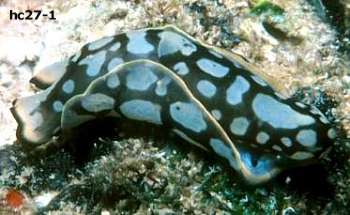
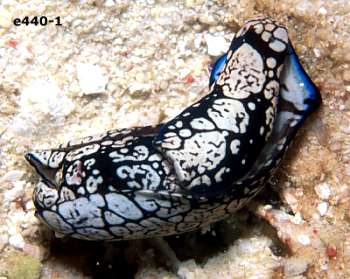
Hi Bill,
I was pleased to see Philinopsis reticulata on the Forum. Some years ago, I found a specimen (hc27-1) in Hawaii that I tentatively identified as that species. A friend later suggested it was a variant of P. pilsbryi (separate message). Later, I came across another P. reticulata-like specimen here at Kwajalein in the Marshall Islands (e440-1), although it is quite different from the Hawaiian one. What do you think?
Scott
johnson@kmr.ll.mit.edu
Johnson, S., 2000 (Jul 31) Philinopsis reticulata? from Marshall & Hawaiian Ids. [Message in] Sea Slug Forum. Australian Museum, Sydney. Available from http://www.seaslugforum.net/find/2792Dear Scott,
Thanks for the photos. Certainly the Marshall Ids animal looks like one of the colour forms of Philinopsis reticulata I illustrate for the Forum. I am not sure whether the Hawaian species is the same as it has a distinct cream border. It does have the same head-shape as P. reticulata (though so does P. pilsbryi), and appears to have the reticulate pattern continuing onto the sole of the foot. I guess as well as comparatative anatomy, we would need more information on the colour variety found in the Marshall Islands.
Any size information I can add to the photos?
Best wishes,
Bill Rudman.
Philinopsis reticulata from Sulawesi
July 30, 2000
From: Lindsay Warren
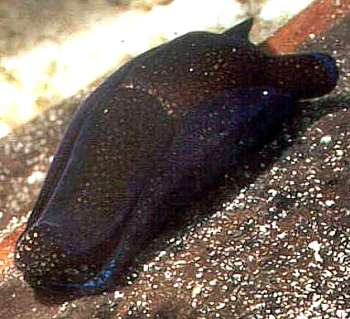
Dear Bill
A further specimen of this unidentified Chelidonura was found by Dean Lea
on 30 July 1999 at a depth of 6 m on a reef running down the centre of a channel between Pulau Hoga and Pulau Kaledupa [Tukang Besi Archipelago, SE Sulawesi, Indonesia - Operation Wallacea]. Size: 8 mm.
This is the same as sent to you before from a find in November 1998 which was a couple of mm smaller. At the time you were not sure if this was a juvenile form of a known species or an undescribed one. Photo: Lindsay Warren.
Do you know if we might be closer to an ID yet?
All the best
Lindsay
alldcl@compuserve.com
Warren, L., 2000 (Jul 30) Philinopsis reticulata from Sulawesi. [Message in] Sea Slug Forum. Australian Museum, Sydney. Available from http://www.seaslugforum.net/find/2780
Dear Lindsay,
This is almost certainly Philinopsis reticulata (Eliot 1903).
The reticulate pattern is characteristic, as are the blue markings on the inside edge of the anterior part of the parapodia. Eliot mentions the blue in his description, and I have found such marks on specimens I have found in East Africa, where Eliot's material came from.
Probably the most important confirmation is the shape of the head. The high median ridge, clearly seen in your photo and in Eliot's painting are an indication that this species is one of the group of Philinopsis with a very long narrow pharynx, as discussed under Philinopsis gardineri.
Eliot describes this as "pharynx of moderate size, 1.5 mm wide" which means little until it is compared with his description of the foregut of a similarly sized specimen of Philinopsis cyanea - "pharynx is colossal ... breadth 15mm" which describes the large buccal bulb, typical of most members of the genus. The illustration to the right is from Eliot, 1903, Pl. 13, fig. 1.
Have a look at the page I have prepared on this species which shows the considerable colour variation found in the species.
The earlier specimen you ask about, is not this species and as a suggested before is almost certainly a species of Chelidonura, not Philinopsis.
Reference: Eliot, C,N.E. (1903) Notes on some new or little known members of the family Doridiidae. Proceedings of the Malacological Society, London, 5(5): 331-337.
Best wishes,
Bill Rudman.
